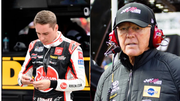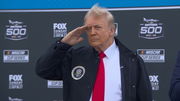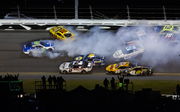

All-Star events have been a part of the American sports culture for a long time. An opportunity to witness the best go against the best, All-Star events have continued to attract humongous crowds with time. NASCAR organized its first All-Star race in 1985. While it might seem too late compared to its fellow sports leagues like Major League Baseball, the All-Star race kicked off its journey with the NASCAR community’s most loved aspect- a controversy.
Former Cup Series sponsor RJ Reynolds Tobacco was the primary propagator for the event. The company funded special incentives, a handsome winning purse amid more notable attractions. Originally named ‘The Winston,’ the inaugural All-Star race was exclusive to a limited number of full-time drivers. With legends of the sport like Dale Earnhardt, Geoffrey Bodine, Bobby Allison, and many more in the fray, Darrell Waltrip crossed the finish line first. But just moments after it, his blown-up engine kickstarted a controversy.
ADVERTISEMENT
Article continues below this ad
Darrell Waltrip’s controversial 1985 NASCAR All-Star race car
The criteria for running the inaugural NASCAR All-Star race differed from those exercised now. Only 12 full-time Cup drivers who scored victories in the 1984 season were allowed to participate in the event. Per the rules, the defending Cup Series champion was awarded the pole position, and Bobby Labonte, the 1984 champion, benefitted from that.
The race was designed to continue for 70 laps, where the best NASCAR drivers battled against each other for 105 miles. A compulsory two-tire pit stop was introduced, which a driver could use between the 30th and 40th lap. A surprising $10,000 bonus was also awarded to the drivers who led the 20th and 55th lap. Held at the iconic Charlotte Motor Speedway, the winner of the All-Star race would receive tempting prize money of $200,000 just a day before the Coca-Cola 600.
The race began with a brief period of Darrell Waltrip‘s dominance as he led the race for 19 laps. Starting on the pole, Bobby Labonte had been close behind Waltrip and overtook him in the 20th lap. This earned Labonte the bizarre $10,000 bonus prize. The duo exchanged leads from the 21st lap to the 37th, following which Harry Gant broke the duopoly and took a comfortable lead after an early pit stop.
Looking at Gant’s dominance, NASCAR fans understood that the lead was too big for Waltrip to make a pass. Surprisingly, Waltrip proved fans wrong by gradually reducing the gap between him and Gant. Waltrip’s car proved to be faster than Harry Gant’s on all the turns, and eventually, the 3-time Cup Series champion took control of the lead. What surprised everyone even more was that Waltrip significantly increased the distance between him and Gant.
NASCAR cars usually run at a similar pace, which is also one reason why passing the race leader is difficult. However, from what Darrell Waltrip showed, it was possible, but yet suspicious. The doubts grew as smoke started coming out of Waltrip’s No.11 Chevrolet shortly after his win. This incident raised eyebrows, as many people felt an illegitimate engine might have been used to give Waltrip an advantage.
Waltrip’s car builder, Junior Johnson, was under the spotlight, as many in the NASCAR community also alleged that Waltrip might have intentionally blown his engine to escape an official investigation by NASCAR. Darrell Waltrip had said it was a special car built for a special occasion.
Read More: WATCH: Tony Stewart and Co. Give Josh Berry an Ultimate Welcome, Make Him Scrub the Floor
Trending
ADVERTISEMENT
Article continues below this ad
Waltrip dismissed the cheating allegations
Darrell Waltrip and Junior Johnson have denied any claims of creating an illegal car. Waltrip had admitted the vehicle’s motor was designed to run for at most 100 miles, and the side effects showed up after a 105-mile NASCAR All-Star race. Revealing the details of the controversial car years after its occurrence, Waltrip said, “We built a special car that had been to the wind tunnel more than any we’d ever built.“
“There was an amazing amount of effort put into that race. Junior ground a set of rods that would run only as long as he thought they needed to run. He did the same thing with pistons and the crank. He used his experience to make that motor good for only as long as it needed to be. But that’s the chance you take with $200,000 on the line. It was a hand grenade motor, and Junior held the pin,” the driver added.
Waltrip also admitted that NASCAR, in some ways, had given teams a free pass to modify the car in any way they wanted. Junior Johnson just capitalized on that to create a race-winning car.
ADVERTISEMENT
Article continues below this ad
The outcome of the 1985 NASCAR All-Star Race could have derailed the event’s legitimacy. Since then, the event has undergone significant modifications, and the community has witnessed its success.
Watch This Story: The Uncertain Road Ahead Matt Dibenedetto’s 2024 NASCAR Journey
ADVERTISEMENT
ADVERTISEMENT
ADVERTISEMENT
ADVERTISEMENT






